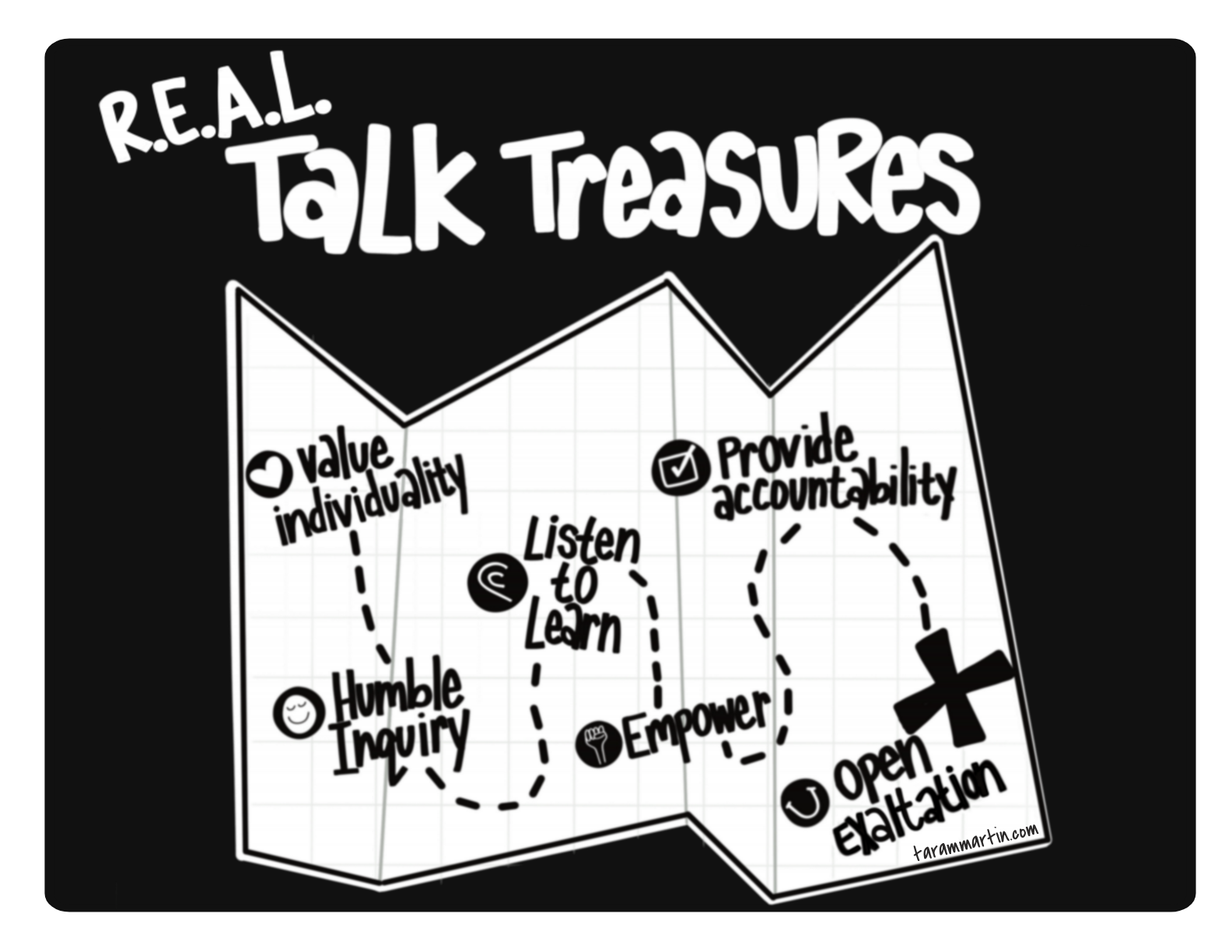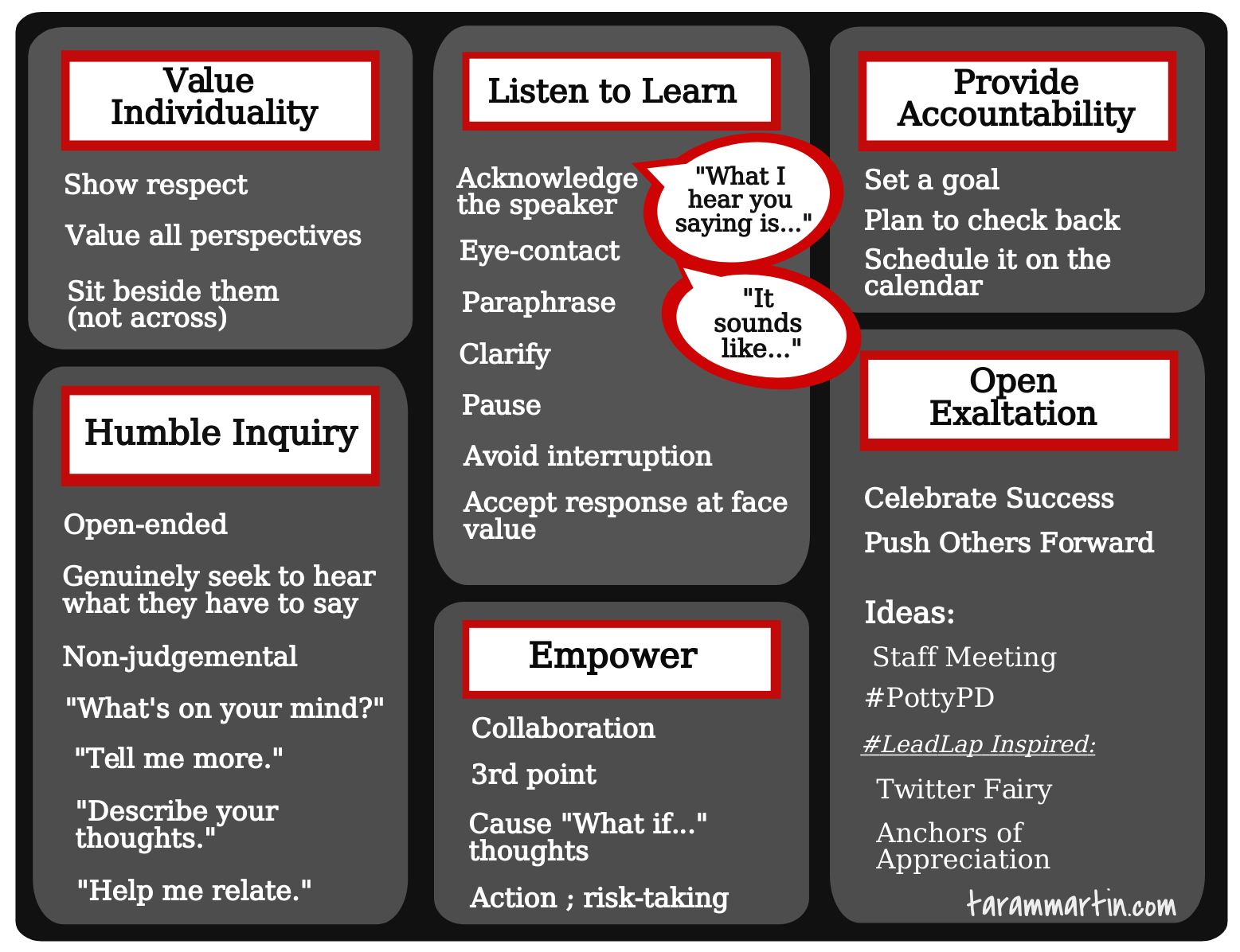REAL Talk Treasure Map
Here are a few REAL Talk Treasures I've learned over the years by watching influential communicators in my life. The treasures listed below are not new ideas, but they are worthy of revisiting. In truth, I often refer to them when mentoring and seeing to multiply the talents and strengths of those I serve.
Front of Map

Back of Map

1. Value Individuality
When we genuinely value others as individuals, we show that we respect and appreciate what they have to offer. Everyone wants to sense their voice and ideas are not only welcomed but encouraged. Non-verbal cues can imply you value the one to whom you are speaking. I try to sit beside them, not across. I also make eye contact and facial gestures (I’m often referred to as the living emoji), which lets people know I’m interested in what they have to say.
2. Humble Inquiry
To me, the best conversations are led with humble inquiry. The term was inspired by a book I read several years back, titled Humble Inquiry by Edgar H. Schein.
My interpretation of humble inquiry is a question that genuinely seeks to hear what the other person has to say. It is not a question designed to give us the answer we hope to attain. As silly as this might sound, I think Facebook does a great job of asking humble inquiry questions—“What are you thinking?” or “What’s on your mind?”
While we might not desire to read these posts online, how might a question such as, “What’s on your mind?” create the foundation of a relatable conversation?
With humble inquiry, conversations will likely get real. There is no telling what the other person might say, but if one is thinking about something, you might want to know that information to identify their current reality—their REAL starting point.
Humble inquiry is also nonjudgmental.
Example: When visiting with a student, a question such as, “Why did you kick that kid on the playground?” might change to, “What’s on your mind right now?” or “What are you thinking about?” There is no judgment. There’s simply an open door to learn more about the student and the incident.
3. Listen to Learn
Listening to learn is tough for me. My mind is continually racing and seeking ways I might solve the problem or help the person in need.
Listening to learn, however, focuses on seeking to understand the perspective of the individual. It’s about showing empathy and uncovering what that person is thinking and feeling—and why.
Pause
When you are listening to learn, pause before you speak. Pausing in conversations might seem awkward sometimes, but it allows thinking space. I don’t know about you, but I cannot stand it when someone constantly interrupts others when they are speaking. The implication made is that the interrupter has something more important to say than what anyone else is saying. In other words, interruption shows a lack of value placed on others’ input. So when a thought jumps to mind, pause. Allow space between the other person’s words and your own. Permit the speaker to clarify the words they left hanging in the air.
Paraphrase & Clarify
Then, paraphrase back to them your interpretation of what they said. Paraphrasing has saved my rear too many times to count. How we interpret the feelings, words, and body language of others is often so far from what they intended. It is common to misinterpret the real meaning of what is being said in an everyday conversation. The reason is fairly simple: We have not walked a day in their life, so we cannot comprehend all of the REAL details.
It is embarrassing how many times I’ve missed the mark during these clarification pieces of a conversation; however, when I paraphrase what I’m hearing, the educator, student, friend, or family member with whom I’m talking then has the opportunity to help me get back on track—and they do!
Accept Response - No Judgment
Once you’re clear on what the other person has said, it’s important to accept their response at face value—with no judgment. They need to feel heard. Like I said earlier, I try to do this but am not always successful. Let’s listen to learn.
4. Empower
Moving forward in a conversation works best when you create a sense of collaboration. During this phase, you can offer advice, if need be, but clarifying questions, a listening ear, and a willingness to brainstorm ideas are most effective.
It helps to have a reference point for the conversation. In Mentoring Matters, Bruce Wellman and Laura Lipton describe this as a third point, as in the focus is not you or the one to whom you are talking; it is on an idea, a topic, or a piece of data. Ultimately, we want others to walk away feeling empowered with something to think about or work toward.
Like Dr. Devin often does for me, the best leaders cause others to walk away from a dialogue with more questions than answers. Rather than feeling intimidated by these questions, they feel motivated to take a new risk and try something they have yet to experience. Empower people to wonder What if…? and to dream about what might happen next if they take action.
5. Provide Accountability
Of course, when you reach this point of the conversation, it is best to set a goal and plan to check back with the person. Offering accountability lets others know you care and you want to see them succeed, which leads us right back to the treasure of feeling valued.
6. Open Exaltation
By exalting others openly, we point out someone’s successes and help them see their own achievements, which makes them feel that “I can do it” attitude. It also helps to create a positive emotional connection to the process of learning and to you. That emotional connection is foundational to building REAL relationships.
A Few Ideas:
"Catch" colleagues shouting out EDUawesomeness through Twitter via school or district hashtag and drop this note with a little fairy dust (glitter). Inspired by @BethHouf.
Are your newsletters ignored via email? Try printing a few and placing them on the backs of the restroom stalls and over the urinals. Click the link above to learn more about learning on the GO!
Let's be intentional when showing our appreciation to those we serve. Click the link above to learn more. Inspired by #LeadLAP authors Shelley Burgess & BethHouf.
REAL Talk Treasures Summary
Being relatable is more than just smiling in the hallway. It requires that we take time to see a situation from another person’s perspective and that we show empathy. Being relatable means that we cannot avoid tough conversations because they might take more time or lead to questions to which we do not have the answers. If we shy away from being REAL in our interactions with those we serve, we miss opportunities to see their point of view. Enduring thirty minutes of a tough conversation might make life impacting differences for not only the one whom you are visiting with but also to all of those whom they interact with from that point forward.
